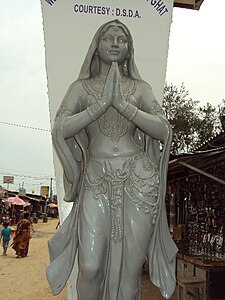Namaste: Difference between revisions
| Line 16: | Line 16: | ||
An even less common variant is used in the case of two people being addressed namely ''Namo vām'' which is a combination of "''Namaḥ''" and the enclitic 2nd person [[dual (grammatical number)|dual]] pronoun "''vām''".<ref name=fm>Thomas Burrow "''The Sanskrit Language''", pp. 263-268</ref> |
An even less common variant is used in the case of two people being addressed namely ''Namo vām'' which is a combination of "''Namaḥ''" and the enclitic 2nd person [[dual (grammatical number)|dual]] pronoun "''vām''".<ref name=fm>Thomas Burrow "''The Sanskrit Language''", pp. 263-268</ref> |
||
== Meaning == |
|||
[[File:An Oberoi Hotel employee doing Namaste, New Delhi.jpg|thumb|325px|Pressing hands together with a smile to greet Namaste – a common cultural practice in [[India]]]] |
|||
In Sanskrit the word is namah + te = namaste ([[Devanagari]]/[[Hindi]]: नमः + ते = नमस्ते), which means “I bow to you” – my greetings, salutations or prostration to you.<ref>{{Citation | publisher = About | title = Hinduism | contribution = What is Namaste | url = http://hinduism.about.com/od/artculture/p/namaste.htm}}.</ref><sup>Poor source</sup> |
|||
== Uses == |
== Uses == |
||
Revision as of 23:35, 16 February 2014
This article needs additional citations for verification. (June 2011) |

Namaste (/ˈnɑːməsteɪ/ NAH-məs-tay; Hindustani pronunciation: [nəməsteː] ⓘ;[2] Namaskar, Namaskaram) is a customary greeting when individuals meet and a farewell when they part.[3] It is a form of greeting commonly found among people of South Asia, in some Southeast Asian countries, and diaspora from these regions.[4][5] Namaste is spoken with a slight bow and hands pressed together, palms touching and fingers pointing upwards, thumbs close to the chest. This gesture is called Añjali Mudrā or Pranamasana.[6] In Hinduism it means "I bow to the divine in you."[4][7]
Namaste is typically spoken and performed with pressed hand gesture, but it may also be spoken without acting it out or performed wordlessly; all three carry the same meaning. This cultural practice of salutation and valediction originated in the Indian subcontinent.[8][page needed]
Etymology

Namaste (properly Namas te) is derived from Sanskrit and is a combination of the word "Namaḥ" and the enclitic 2nd person singular pronoun "te".[9] The word "Namaḥ" takes the Sandhi form "Namas" before the sound "t".[10]
Namaḥ means 'bow', 'obeisance', 'reverential salutation' or 'adoration'[11] and te means 'to you' (dative case). Therefore, Namas te literally means "salutations to you".
In principle Namas te is to be used only when a single person is addressed (since in Sanskrit "te" is singular) but it is nowadays commonly used no matter how many people are addressed.
A less common variant is used in the case of three or more people being addressed namely Namo vaḥ which is a combination of "Namaḥ" and the enclitic 2nd person plural pronoun "vaḥ".[9] The word "Namaḥ" takes the Sandhi form "Namo" before the sound "v".[10]
An even less common variant is used in the case of two people being addressed namely Namo vām which is a combination of "Namaḥ" and the enclitic 2nd person dual pronoun "vām".[9]
Uses

The gesture is widely used throughout Asia and beyond. It first appears c. 4 000 years ago on the clay seals of the Indus Valley Civilization.[12]Poor source
See also
References
Notes
- ^ B Bhasin, Doing Business in the ASEAN Countries, ISBN 978-1-60649-108-9, pp 32
- ^ Sanskrit English Disctionary University of Koeln, Germany
- ^ Constance Jones and James D. Ryan, Encyclopedia of Hinduism, ISBN 978-0-8160-5458-9, pp 302
- ^ a b Ying, Y. W., Coombs, M., & Lee, P. A. (1999), Family intergenerational relationship of Asian American adolescents, Cultural Diversity and Ethnic Minority Psychology, 5(4), pp 350-363
- ^ Bhatia, S., & Ram, A. (2009). Theorizing identity in transnational and diaspora cultures: A critical approach to acculturation. International Journal of Intercultural Relations, 33(2), pp 140-149
- ^ Chatterjee, Gautam (2001), Sacred Hindu Symbols, Google books, pp. 47–48.
- ^ Lawrence, J. D. (2007), The Boundaries of Faith: A Journey in India, Homily Service, 41(2), pp 1-3
- ^ D. Ikeda, D. & V.P. Nanda (2004), The Spirit of India: Buddhism and Hinduism (2), Journal of Oriental Studies, 14, pp 3-47
- ^ a b c Thomas Burrow "The Sanskrit Language", pp. 263-268
- ^ a b Thomas Burrow "The Sanskrit Language", pp. 100-102
- ^ "Cologne Digital Sanskrit Lexicon", Cologne Digital Sanskrit Dictionaries (search results), University of Cologne, retrieved March 24, 2012.
- ^ "Mysterious Nagas", Khandro.
External links
- Koul, Omkar N (2003-08-10). "Modes of Greetings in Kashmiri" (PDF). Indian Institute of Language Studies.
{{cite journal}}: Cite journal requires|journal=(help) - Kumar, Nitin. "Namaste – The Significance of a Yogic Greeting". Exotic India. Retrieved 9 March 2012.
- Greenwood, Chad (Fall 1997), "Ancient Indus Valley Seal print showing namaste/anjali mudra", Economics of the Indus valley civilisation, CSU Chico.
